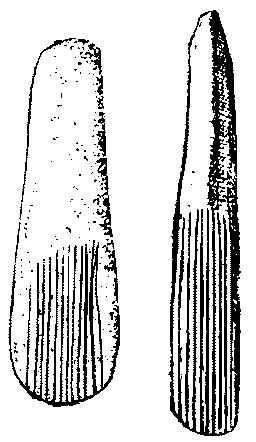 |
Science Frontiers ONLINE No. 77: Sep-Oct 1991 |
|
|
A Paper Trail From Asia To The Americas
 Stone beaters used in making bark paper from Mesoamerica (left) and Southeast Asia (right) |
The manufacture of bark paper requires characteristic grooved beaters, specimens of which have been found in both Mesoamerica and Southeast Asia. Were bark paper and the tools required to make it invented independently on both sides of the Pacific, or were they transported across the Pacific by early navigators? If the latter, the flow was probably from Asia to America because the paper-making tools first appeared in Southeast Asia 4-5000 years ago and in Mesoamerica only 2500 years ago. Even so, trans-Pacific voyages 2500 years ago are definitely not part of acceptable archeology.
Anthropologist P. Tolstoy, swimming against the mainstream, has surveyed the manufacturing technology of both bark paper and ordinary paper on a worldwide basis. He identified some 300 variable features in the process, 140 uses of the final products, and 100 specific details of bark beaters. Tolstoy concluded:
"All this points to the direct transfer of technology from Southeast Asia to Mesoamerica, apparently by a sea voyage that took place about 2500 years ago."
Tolstoy rejects the tapa (bark cloth) of Polynesia as a credible link between Southeast Asian and Mesoamerican barkpaper making. The technology transfer was not island-to-island but direct! Invoking Kon Tiki and the prevailing currents and winds, he postulates a 2500-year-old voyage swinging north of Hawaii along an islandless route to Mesoamerica.
(Tolstoy, Paul; "Paper Route," Natural History, 100:6, June 1991.)